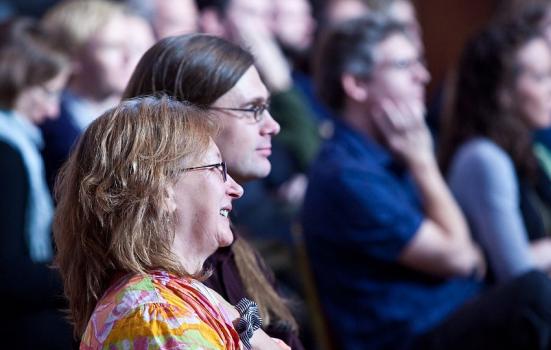Who really benefits from ‘pay what you can’ and ‘pay what you decide’ ticketing offers? Two organisations reveal whether it worked for them.

Dan Sumption (CC BY-NC 2.0)
ARC in Stockton recently introduced a ‘pay what you decide’ pricing system across its full programme. Annabel Turpin assesses whether the bold move paid off.
In January 2015, at ARC in Stockton-on-Tees we introduced ‘pay what you decide’ (PWYD) pricing on the entire theatre, dance and spoken word programme for a six-month trial period. Described by many as a bold move, the intention was to reduce the financial risk for customers, help attract new people to theatre and encourage existing audiences to come more often.
Many venues have offered ‘pay what you can’ (PWYC) pricing for years, but PWYD is distinctly different. PWYC is about affordability: customers still pay in advance but set the price themselves. The implication is that they pay what they can afford. With PWYD, customers book a ticket without making any payment, then decide after the show what they think it is worth. This removes the risk of paying for something they might not enjoy.
PWYD has been our way of making a statement to customers that we are so confident that they will enjoy themselves that they can come for free
Our artistic policy is to present new work, so we are asking customers to take a big risk. We don’t present set texts, classics or adaptations, we don’t feature TV or well-known stage names, and often it doesn’t look like traditional theatre either. We seek out work we feel is relevant to our potential audiences, that is exciting, different and offers something we can connect with, whether that’s a character, storyline, emotion or situation.
However, persuading people to come is still a challenge. Stockton and its neighbouring boroughs are in the bottom 20% of arts engagement. ARC itself is situated in one of the UK’s most deprived wards. Our audience development strategy has demanded persistence, imagination and risk, but this has always been balanced by our absolute confidence in the programme. We work with some of the best artists and companies in the UK and have no reason to doubt that people will enjoy what they see. PWYD has been our way of making a statement to customers that we are so confident that they will enjoy themselves that they can come for free - and if they don’t like it they don’t have to pay.
It was widely publicised. Customers still booked in advance, so we could explain the scheme as well as capture their data, but no payment was required. Tickets not collected 15 minutes before the show were released, as with any ‘free’ ticketing we knew there would be a drop-off. Having anticipated this might be as high as 50%, we were delighted to find it averaged 32% over the season. We made no announcements, and opted not to indicate a suggested ticket price. At the end of the show, a clearly labelled transparent box was held by the usher, and customers could also pay by card at the box office. As there was no obligation to pay anything, income could be treated as donated income, so we could claim Gift Aid on up to £5,000 of unattributed donations per year.
There is very little evidence available on PWYD. With the exception of Slung Low’s HUB in Leeds, we couldn’t find any other venue offering this model. We received huge interest from other venues, both UK and internationally, so we pledged to share the results of our trial – whatever they were. This is what happened.
- Our theatre audiences increased by 58%, box office income by 82% and average ticket yield by 11%.
- Audiences entirely new to ARC increased from 5.9% to 10%. Audiences that had attended other artforms (comedy, music, cinema), but were first-time theatre attenders, increased by 5%.
- Our Routes North commission, which played in the studio over two nights, attracted 43 in 2014 and then to 69 in 2015, despite having more challenging content. Income on this event was up by 63% and 17 bookers were new to seeing theatre at ARC.
- Tangled Feet increased its audience by 76% between its visits in January last year and March this year, with income up by 77%.
- Typically, where most studio shows were attracting around 20 people, we are now consistently attracting audiences of 40 or more, and in our theatre space, average audiences have risen from 50 to between 60 and 90.
Keen to find out more, we surveyed PWYD audiences and this is what they told us:
- Nearly half said that PWYD had been a factor in deciding to come, with 30% saying that PWYD affected their choice of show. 22% said they wouldn’t have come if the show hadn’t been on a PWYD basis.
- More than 60% said they came more often, a key aim for us.
- When we introduced PWYD, many customers said they could now bring friends and family, who were often reluctant to come. Our research showed 30% saying PWYD had enabled them to bring other people.
We were particularly interested in how people had decided how much to pay. The three main factors were their overall enjoyment of the show (70%), their current financial situation (44%) and how well they thought the artists had performed (40%). PWYD therefore seemed to be addressing affordability as well as risk. 87% of customers told other people which has been valuable word-of-mouth publicity.
We also looked at the impact on artists and companies. All artists performing during the trial period were on guaranteed fees (often against splits), and we talked to them in advance about PWYD. 40% said it affected their relationship with the audience, stating that it felt more like a direct relationship, and led to a heightened awareness that some people in the room might be having their first experience at ARC. Two thirds of companies said it affected the way they promoted their show, allowing them to promote it more widely, to target groups and communities without the difficulty of asking them to pay.
Overall, PWYD has been a big success – and we plan to continue it indefinitely. There may come a time, when every show is selling out and with no means of increasing prices PWYD becomes problematic, but right now it feels like a great mechanism for bringing new people in.
Nick Hallam explains how a ‘pay what you can’ offer worked for West Yorkshire Playhouse.
Pay what you can and pay what you decide are not new ideas, but it’s been interesting to see their resurgence in recent months, not least ARC’s ground-breaking, season-long experiment, which anyone who works in the arts should stand and applaud. Our experiment, while less ambitious, was nonetheless an important project in re-establishing audience development at the heart of all our campaigns. Over the years, our marketing has become very focussed on show by show campaigns, so this is just the first of many projects over the coming season.
Our project was pay what you can (PWYC) as opposed to pay what you decide (PWYD). We wanted to test what price audiences would be prepared to pay before they came to the show, rather than after they’d seen it (we will test the latter on another show in the autumn). We were absolutely clear that it was a way of encouraging people to attend because they could get cheap tickets.
It was the beginning of a culture change within the marketing and communications department
There had to be no barriers or obstacles to booking a PWYC ticket – it had to be as easy as booking a regular ticket – which meant that it had to be available online. Whilst we recognised at the outset that it would be impossible to have every single price permutation on the website, we took a leap of faith that audiences wouldn’t take us at our word when booking online. If they did, we would point out the limitations of online booking and suggest that they call the box office if they wanted to pay a different price. In any event, there were no complaints and no one to our knowledge chose the ‘phone the box office instead’ route. Online sales for the performance were the same as any other show. The online prices offered were 1p, 5p 10p, 50p, £1, £2.50, £5, £10 and, of course, all our normal range of prices up to £29.
The offer was set for a preview performance of ‘The Rise and Fall of Little Voice’ and was launched two weeks ahead of that performance. We wanted the story to be about the accessibility of the Playhouse, so the story was run in the Yorkshire Evening Post and was also picked up by BBC Radio Leeds for whom our Artistic Director, James Brining, did a live interview on the day before the event. The performance was a sell out with 76% of tickets being sold in the last week, including 22% on the last day following the radio interview.
The statistical highlights were:
- 44% paid less than £5 per tickets and 72% less than £10.
- 66% said that they wouldn’t have attended if they had had to pay the full price.
- Encouragingly, 100% said that they would be returning for another show.
- 88% said that they would be more likely to take risks on seeing a show if it was PWYC.
- 95% said that they would be telling their friends about the production – with 100% giving it a 4 or 5 star rating.
In view of what we were testing, we judged the project a success. It was the beginning of a culture change within the marketing and communications department, we established the limits of our online booking system (although we have since changed our website and have installed Spektrix so it is far more flexible than when we ran the offer), we learnt about the reasonableness of our audiences in relation to the online offer not being literally ‘Pay What You Can’ (although it was available via phone or in person), and we received excellent media coverage and gave our Artistic Director a platform to talk about our generic approach to ensuring the Playhouse is an open and accessible organisation. On a very pragmatic level, we also had a full preview performance with the best part of 750 people going on to recommend the show to their friends and families having seen a brilliant show.
Going forward, it has been a very useful experiment. I don’t think, in the end, we would class what we did as ‘audience development’, but we know how to use the tools of the project for the future when it will be more targeted. However, if its function is to fill one of those difficult-to-fill preview performances, it is still an incredibly useful pricing tool to have in the box.
As was mentioned above, we will also now test pay what you decide and ask people to pay as they leave. We are looking forward, with equal excitement, to analysing the results.
Annabel Turpin is Chief Executive of ARC Stockton and Nick Hallam is Communications Director at West Yorkshire Playhouse.
arconline.co.uk
www.wyp.org.uk




